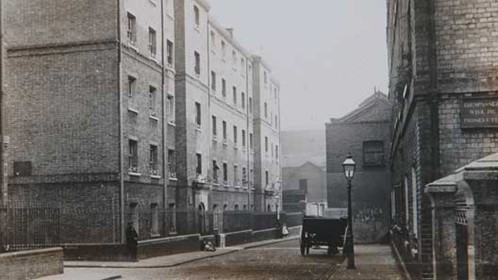The Whitechapel estate in East London was the first of 10 estates which Peabody built as part of London's earliest slum clearance programme. In 1875 the Metropolitan Board of Works, the forerunner of the LCC and the GLC, was given compulsory purchase powers by Parliament. It looked for organisations which could replace the slums with model dwellings, and Peabody was among those chosen.
Old maps show that the site of the estate had previously been a maze of narrow courtyards filled with cramped and unhealthy houses. Peabody’s architect, Henry Darbishire, designed 11 blocks to be built on the cleared land.
The estate opened in 1881 and provided 286 flats. Within months it was visited by members of a Select Committee on Housing, who wanted to see the results of the 1875 legislation. Weekly rents started at three shillings (15p) for a one-room flat and went up to six shillings (30p) for three rooms. In 1910, we bought more land and added Block L.
On 8 September 1940, Block K was destroyed in an air raid and nearly 80 people were killed. It was the worst disaster to hit any Peabody estate in the Second World War. The block was not rebuilt, and Block D was demolished as it had been badly damaged. In 1995 a memorial was unveiled at the estate. It lists the names of the people known to have died in the tragedy.

Got a question about our archive – or have a story to tell?
Please email: history@peabody.org.uk
Please include a postal address or telephone number so that we can reply to you.
